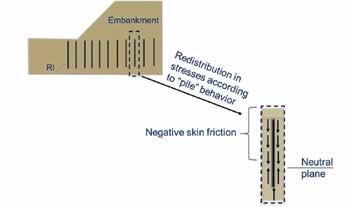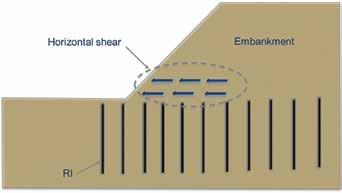
10 minute read
Panel on soil improvement by Rigid Inclusions
Rigid inclusions being installed for tanks, energy facilities in Connecticut. PHOTO CREDIT: KELLER.
This article was originally published in DFI’s bi-monthly member magazine, Deep Foundations, Sept/Oct 2020 issue. DFI is an international technical association of firms and individuals in the deep foundations and related industries. To join DFI and receive the magazine, go to www.dfi.org.
Rigid Inclusions (RIs) are cementitious columns that are significantly stiffer than the surrounding soil and are used to improve ground performance. The use of RIs has gained widespread acceptance, but common misconceptions or concerns can exist among engineers who are less familiar with RI differences from piles regarding their design and behavior. To address issues related to RIs, a panel was assembled for an interactive discussion during the American Society of Civil Engineer’s (ASCE) Geo-Congress held in February. This article reviews the panel’s discussion of various RI uses and RI design and reinforcement needs. Moderated by José Clemente, the panel was made up of DFI and ASCE members, consisting of six practitioners and one academic: • José Clemente (moderator), Ph.D., P.E., D.GE, Bechtel
Corporation • Tanner Blackburn, Ph.D., P.E., Keller Foundations • Jie Han, Ph.D., University of Kansas • Roberto Lopez, P.E., Malcolm Drilling • Morgan NeSmith, P.E., Berkel & Company • Timothy Siegel, P.E., G.E., D.GE, Dan Brown and Associates • Sonia Swift, Menard Group USA
RIs are not structurally connected to the superstructure. Instead, a load-transfer fill mat or platform is typically installed between the top of RIs and the bottom of a superstructure. This arrangement allows for load sharing with the surrounding soil.
Topics discussed at the panel included stress distribution between RIs and soil, RI use for settlement control and liquefaction mitigation, performance, and design of RIs under seismic loading, and steel reinforcement of RIs. Quality assurance/quality control (QA/QC) issues were also discussed as briefly summarized in this article from the panelists.
sEttlEmEnt control
Initial development of RIs in Europe in the 1970s was to support area loads such as highway embankments, tank foundations and structures on mat foundations. RIs continue to be used extensively for these applications. Typically, the main geotechnical consideration has been settlement reduction. Because of their load-sharing capabilities, RIs carry part of the foundation load (figure 1) reducing stresses on the soil and consequently reducing total and differential settlements. Additional benefits can be derived when RIs are installed in granular soils by using displacement methods that can result in densification of the soil surrounding the RIs. Serviceability limit state (settlement) design is employed, and the RIs are typically not reinforced. Use of RIs for settlement reduction has been extended to carry concentrated loads under footings in a manner analogous to a pile. In these cases, the bearing capacity of the RIs becomes a geotechnical consideration that must be accounted for.

Figure 2: Embankment stress distributions along length of RIs.

Figure 3: Horizontal shear with RI-supported embankment.

Figure 4: RI-soil interactions from seismically induced loadings.
QA/QC aspects include field verification of soil densification and/ or load testing of RIs to confirm design assumptions. Load testing is often carried out on individual RIs, and this is particularly suitable when RIs carry concentrated loads. Load testing of large-scale footings with multiple RIs is sometimes needed to verify soil/RI response to loading. Settlement monitoring during, and sometimes after, construction is recommended.

strEss Distribution
RIs and the surrounding soil will behave as a composite system. Thus, a rational representation of the soil-RI interaction is a fundamental aspect of RI design. For instance, when the distribution in load between the RIs and the soil is evaluated using a large-scale plate load test, the distribution varies with footing pressure. At lower footing pressures (and smaller displacements), the RIs resist a higher percentage of the load as compared to higher footing pressures and larger displacements. In the case of RIs within an embankment, vertical stresses from the overlying embankment will cause settlement and negative skin friction along the length of the RIs (figure 2). As a result, the RIs will behave like piles. It may seem intuitive that the RIs beneath an embankment may be considered to be in pure shear in a conventional limit equilibrium analysis; however, consideration should be made for the fact that the RIs will attract the embankment stress and transfer that stress deeper into the soil profile.
In addition, horizontal shear stresses are present near the edges of embankments (figure 3). The design of underlying RIs should thus consider the shear and bending resulting from the embankment shear stresses, as well as other potential loading/stress conditions when more complex design demands exists.
liquEfaction mitigation
RIs can provide stiffened soil responses to seismic loading. This effect is more pronounced when the RIs are installed using full soildisplacement methods that do not remove soil from the ground. Typically, the displacement of predominantly coarse-grained soils results in densification of these soils surrounding the installed RIs, consequently increasing their resistance to seismic loading. The required increase in resistance is determined by analytical methods and is verified by QA/QC activities that include performing in situ tests before and after RI installation.
Verification of increase in soil density, strength, and modulus is typically needed to ensure that design requirements are met. In situ tests routinely performed include the standard penetration test (SPT), cone penetration test (CPT) and dilatometer test (DMT), as well as shear wave velocity (Vs) measurements.
A detailed case history of drilled displacement rigid inclusions used for liquefaction mitigation was presented in the January/February 2019 edition of Deep Foundations magazine.
sEismic loaDing
RIs have limited lateral capacity and stiffness because of their relative slenderness and lack of — or limited — reinforcement. As a result, they elicit brittle behavior under lateral loading conditions. In areas of moderate to high seismicity, earthquake-induced lateral
loading of RIs is a significant design consideration. Seismic loading of RIs results from a combination of inertial loading due to dynamic response of the superstructure being supported, and kinematic loading due to transient or permanent ground deformation during an event. This loading and deformation due to a seismic event will impose bending moments throughout the entire length of the element, which must be incorporated into the RI design.
Vertical load (P) and overturning moments (M) applied to a foundation by seismic inertial loading must be incorporated into the vertical loading design of the RIs (figure 4). Shear loads (V) are resisted by passive soil resistance against the foundation and through shear transfer to the load transfer platform and to the soil and RIs below it.
In addition to the inertial superstructure loading, the kinematic loading due to transient or permanent soil deformation is significant and must be included in the structural evaluation of RI elements. While the soil-structure interaction during seismic events is complex, simplified methods of analysis are available that may suffice for many RI projects. In addition, fully coupled, 3-D numerical analysis methods are available for critical projects.
Transient free-field soil displacement can be estimated by performing site response analyses, and permanent soil displacements can be evaluated using seismic slope stability methods. These free field soil-displacement distributions can be applied as a pseudostatic kinematic load to a beam on a nonlinear Winkler foundation analysis (for example, L-Pile). The structural response of the RI to the pseudostatic deflection would be investigated and moment capacity versus demand would be checked. Locations with significant moment demand typically occur at inflection points in the soil displacement profile (interfaces between soft and stiff soils) and in zones of higher curvature (see red circles in figure 4).
The performance of RIs subjected to seismic inertial and kinematic loading must be evaluated for both capacity and serviceability objectives. If moment demand exceeds capacity, there is a potential for plastic hinges to develop. That situation has potential engineering consequences and impacts on system performance, such as decreased system bearing capacity and additional settlement, and must be addressed.
stEEl rEinforcEmEnt
RIs are typically unreinforced, fully grouted elements that are designed to resist axial compressive forces. However, there are some conditions in which RIs are reinforced, either with a single center steel bar or with a steel cage. Typical design scenarios that require reinforcement of RIs include: when RIs need to resist tensile forces; when RIs are subjected to large lateral forces or bending moments (typically due to lateral movement of walls or embankments); when RIs are used to resist seismic forces (shear); and, when constructability concerns exist, such as: RIs being closely spaced and requiring installation in two passes; expected site heave during RI installation; follow-on work that involves significant excavations; or when vibrations occur near installed RIs.
Reinforcement used for constructability reasons consists of a single steel center bar installed over the top 10 to 20 feet (three to 6.1 metres) of the RIs. The purpose of the steel is to provide the RIs with more capacity and to maintain continuity in the event of cracking. RIs are also occasionally used to resist tensile forces or to support embankments over soft soils that experience large lateral movements during construction. In these cases, the RIs are reinforced with steel cages to resist lateral forces.
The design of steel-reinforced RIs varies drastically depending on the reason for the reinforcement. Typically, no reinforcement design is required when RIs are reinforced solely for constructability concerns. The bar is typically sized based on construction practices and material availability, and is most often a No. 8 bar, Gr. 60 steel. In these cases, the RI is installed and then the steel bar is pushed into the center of the RI. When the reinforcement is required for tensile forces, the RI is designed to structurally resist the tensile force. Then, the geotechnical capacity of the soil surrounding the reinforced portion of the RI is checked, since that capacity generally dictates the length to which the steel reinforcement needs to extend. For RIs resisting large lateral forces, bending moments, or that are subjected to seismic forces, the design generally follows guidelines similar to those used for auger-cast piles.
conclusions
RIs can be used for a variety of ground improvement applications ranging from settlement control to liquefaction mitigation. Design of RIs needs to account for proper load-sharing considerations, including inertial and kinematic loading under seismic conditions. Steel reinforcement is generally not used, but is required when RIs are subjected to uplift, bending and lateral loading. A robust QA/ QC program is essential to confirming the effectiveness of RIs for the applications discussed here.
José Clemente, Ph.D., P.E., D.GE, is the manager of geotechnical engineering for Bechtel. He’s also a Bechtel Fellow and vice chair of the Geo-
Institute’s Soil Improvement Committee for the American Society of
Civil Engineers. Tanner Blackburn, Ph.D., P.E., is vice president of engineering for Keller
North America. He has over 15 years of experience in geotechnical engineering design and construction. Jie Han, Ph.D., is the Glenn L. Parker Professor of Geotechnical Engineering at the University of Kansas and chair of the Geo-Institute’s Soil
Improvement Committee for the American Society of Civil Engineers. Roberto Lopez, P.E., is chief engineer for Malcolm Drilling. He has over 30 years of experience and oversees the technical aspects, design and engineering of projects in the United States. Morgan NeSmith, P.E., is Berkel’s director of engineering and the immediate past chair of the DFI Augered Cast-In-Place and Drilled Displacement Pile Committee as well as a current member of the DFI Board of
Trustees. Tim Siegel, P.E., G.E., D.GE, is CEO and a senior principal engineer for
Dan Brown and Associates and chair of DFI’s Ground Improvement
Committee. He has over 25 years of experience in foundations and ground improvement. Sonia Swift is the design manager at Menard USA and has 14 years of experience in the industry. She focuses on ground improvement design and construction. l






